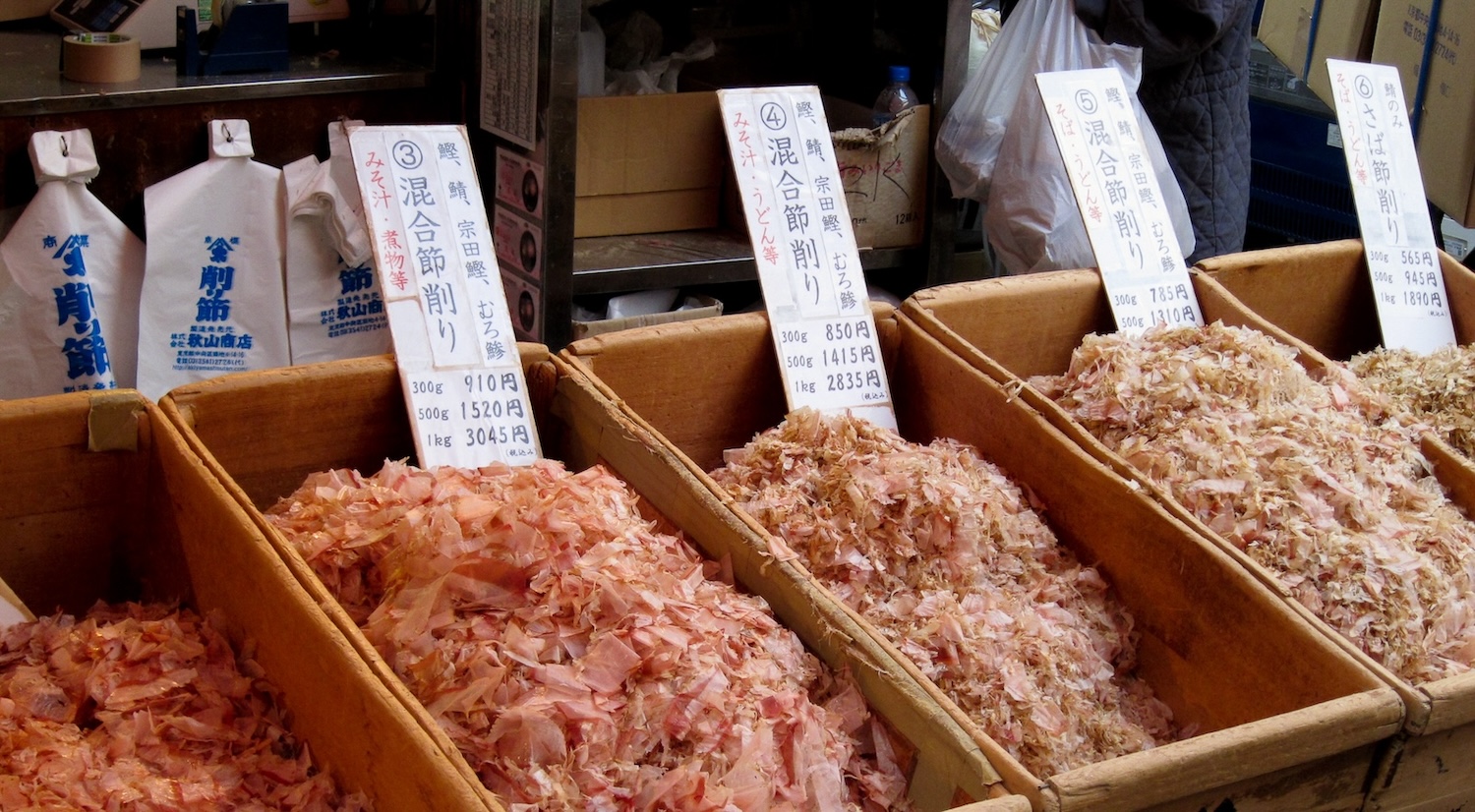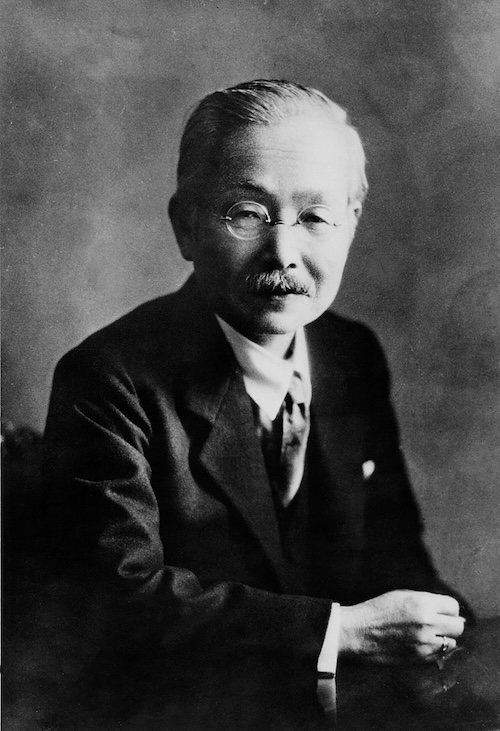Dashi, a cornerstone of Japanese gastronomy, represents the epitome of umami — a flavor profile revered for its savory richness and depth.
At its core, dashi serves as the foundation upon which countless Japanese dishes are built, extending beyond a mere clear broth.
Its delicate yet complex taste, characterized by the subtle interplay of umami-rich ingredients like kombu (dried kelp) and katsuobushi (dried bonito flakes), forms the backbone of soups, stews, sauces, marinades and more. From the humble beginnings of a pot of simmering water emerges a versatile and multi-dimensional liquid that enriches every dish it touches.
Related: Common Types of Ramen
Dashi Ingredients
Kombu is a type of brown algae that grows in underwater forests along the coastlines of Japan, Korea and other East Asian countries. It's one of the most widely consumed seaweeds in Japanese cuisine.
Kombu typically comes in large, thick, dark green or brownish sheets, and its texture is smooth and leathery, and usually sold dried. When dried, kombu can range in color from deep green to nearly black. It has a subtly sweet and briny flavor with a distinct umami taste, making it a prized ingredient in Japanese cooking.

Katsuobushi is made through a labor-intensive process that involves filleting and boiling fresh tuna, then smoking and drying the fillets. After the initial drying process, the fish is inoculated with mold cultures to aid in fermentation. The fish is then left to dry and ferment further in a controlled environment for several months to develop its characteristic flavor and texture.
Once fully dried and fermented, the katsuobushi is shaved into thin flakes using a special tool called a katsuobushi kezuriki. These flakes are paper-thin and have a firm, slightly chewy texture. The shaving process is crucial for maximizing the surface area of the katsuobushi, allowing it to release its flavor quickly when added to hot liquid. In addition to being used in dashi, katsuobushi is also commonly used as a topping for various Japanese dishes, such as okonomiyaki (savory pancakes), takoyaki (octopus balls) and tofu dishes. It can also be ground into a powder and used as a seasoning, or incorporated into sauces and marinades to add depth of flavor.

How to Make Dashi
While the process may vary slightly depending on the recipe and desired outcome, traditional dashi is typically made by steeping kombu in water over low to medium heat until the liquid reaches a gentle simmer, rather than a rolling boil. Boiling kombu at too high a temperature can release bitter compounds and negatively affect the flavor of the dashi.
Once the kombu has been simmered for some time (usually around 20-30 minutes), it is often removed from the pot, and the liquid is then brought to a boil. Once boiling, katsuobushi is added to the pot, and the mixture is immediately removed from the heat and allowed to steep for several minutes. This allows the bonito flakes to infuse their smoky, savory flavor into the dashi without overcooking them.
After steeping, the dashi is strained to remove the kombu and bonito flakes, leaving behind a clear, flavorful broth that can be used as a base or enjoyed as is. The gentle simmering process helps to extract the maximum amount of flavor from the kombu and bonito flakes while preserving the delicate nuances of the ingredients.
Dashi in a Recipe: Ochazuke with Yaki Onigiri
Dashi Variations
Although classic dashi traditionally only has two ingredients, there are other varieties of dashi used just as frequently in Japanese cuisine.
Niboshi dashi, made from dried anchovies, offers a unique depth of flavor with a hint of brininess. To make niboshi dashi, dried anchovies are gently simmered in water, imparting their savory essence to the liquid. This dashi variety is particularly popular in regions like Kyushu and Okinawa, where seafood plays a prominent role in local cuisine.
Another variation, shiitake mushroom dashi, is a vegetarian-friendly alternative that boasts a rich, earthy flavor profile. Dried shiitake mushrooms are soaked in water and then simmered to extract their umami-rich essence. This dashi variety is prized for its versatility and is often used as a base for vegetarian soups, stews and sauces.
All of these dashi ingredients share a very important relation — they are heavy in umami flavor. This flavor profile has been already mentioned a few times now, but further understanding of this taste allows for a deeper appreciation of this complex culinary marvel.
All of these dashi ingredients share a very important relation — they are heavy in umami flavor.
What Is Umami?
Umami, often described as the fifth taste alongside sweet, sour, salty and bitter, is the secret ingredient that elevates dishes from good to extraordinary.
But what exactly is umami? In simple terms, umami is the taste sensation associated with savory, meaty flavors — a sensation that lingers on the palate, leaving a sense of satisfaction and contentment. The concept of umami is not a recent discovery; in fact, it has been recognized by cultures around the world for centuries. However, it wasn't until the early 20th century that umami was formally identified by the Japanese chemist Kikunae Ikeda.

In 1908, Ikeda became intrigued by the unique taste of dashi. He noticed that dashi had a distinct flavor that couldn't be categorized into the four basic tastes recognized at the time: sweet, sour, salty and bitter. Determined to uncover the mystery behind this taste, Ikeda embarked on a series of experiments to isolate and identify the compounds responsible.
Through meticulous experimentation, Ikeda succeeded in isolating glutamate as the key component responsible for the savory taste of dashi. He discovered that glutamate, when present in certain foods, elicited a pleasant, savory taste sensation that complemented other flavors. This glutamate is naturally occurring in both kombu and katsuobushi, which synergize together to enhance said flavor in dashi.
Other ingredients such as tomatoes, mushrooms and aged cheeses, provide a bounty of glutamate, enriching dishes with savory depth and complexity. Ikeda coined the term "umami" to describe this unique taste, deriving it from the Japanese words "umai" (delicious) and "mi" (taste).
Related: Discovering the Savory Benefits of Umami
MSG: The Hero Becomes the Villian
Ikeda's groundbreaking research not only identified umami as a distinct taste but also paved the way for a deeper understanding of the role of glutamate in flavor perception. His work laid the foundation for subsequent studies into umami and its physiological effects, shaping our understanding of taste and flavor in the culinary world.
After identifying glutamate as the compound responsible for the savory taste sensation of umami, Ikeda sought to create a stable and easily accessible form of glutamate that could be added to foods to enhance their flavor.
In 1909, Ikeda and his collaborator, Shintaro Kodama, successfully developed a method to produce monosodium glutamate by fermenting starches or sugars with glutamate-producing bacteria. They then crystallized the resulting glutamate salt, creating a white, odorless powder with a high concentration of glutamate. Ikeda patented this process and began commercial production of MSG under the brand name "Ajinomoto," which translates to "essence of taste" in Japanese. MSG quickly gained popularity as a flavor enhancer, prized for its ability to intensify and round out the flavors of various dishes without imparting a specific taste of its own.
However, despite its ubiquitous presence in the culinary landscape, MSG became the subject of intense scrutiny and vilification in Western media during the latter half of the 20th century. The controversy surrounding MSG stemmed from a series of unsubstantiated claims linking its consumption to adverse health effects, including headaches, nausea and allergic reactions.
The origins of MSG's vilification can be traced back to a letter published in the New England Journal of Medicine in 1968, in which Dr. Robert Ho Man Kwok described experiencing symptoms he attributed to the consumption of Chinese food, which he surmised contained MSG. This anecdotal report sparked widespread concern through media, despite no legitimate studies backing the claim.
This led to subsequent research that failed to provide conclusive evidence linking MSG to adverse health outcomes in the general population. However, the stigma surrounding MSG persisted, fueled by sensationalized media reports and consumer misinformation.
The term "Chinese Restaurant Syndrome" was coined to describe the collection of symptoms attributed to MSG consumption, further perpetuating the negative perception of the flavor enhancer. Decades later, even more confusion about this popularized claim came about, as a man named Howard Steel claimed in a letter to the New York Times in 1993 that he was the real submitter of the letter originally attributed to Dr. Ho Man Kwok. In his letter, Steel stated that he had used the pseudonym "Ho Man Kwok" and written the letter as a prank, not expecting the journal to regard his writings seriously. However, this admission could not be confirmed due to conflicting information regarding the family of a real Dr. Robert Ho Man Kwok insisting it was a real letter, not a prank. Nevertheless, the stigma surrounding MSG continues to influence consumer perceptions and food choices to this day.
Despite the lack of scientific consensus on the safety of MSG, regulatory bodies such as the U.S. Food and Drug Administration (FDA) have consistently affirmed its status as a Generally Recognized as Safe (GRAS) ingredient when used in accordance with good manufacturing practices.
In recent years, efforts to dispel myths surrounding MSG and educate consumers about its safety have gained traction. Scientific organizations and health authorities have reaffirmed the safety of MSG, emphasizing its role as a flavor enhancer that can contribute to enjoyable and satisfying culinary experiences when used responsibly.
Nonetheless, the legacy of MSG's vilification serves as a cautionary tale about the power of misinformation and the importance of evidence-based decision-making in matters of food and health.
More Umami-Packed Ingredient Exploration: Types of Soy Sauce




